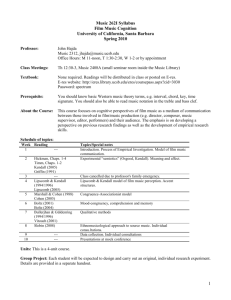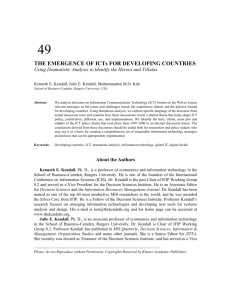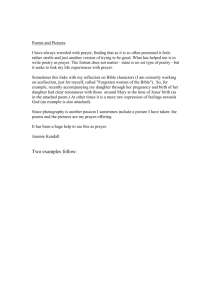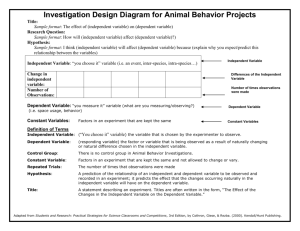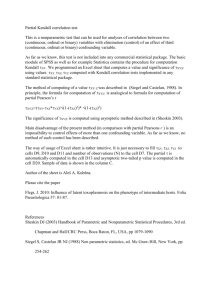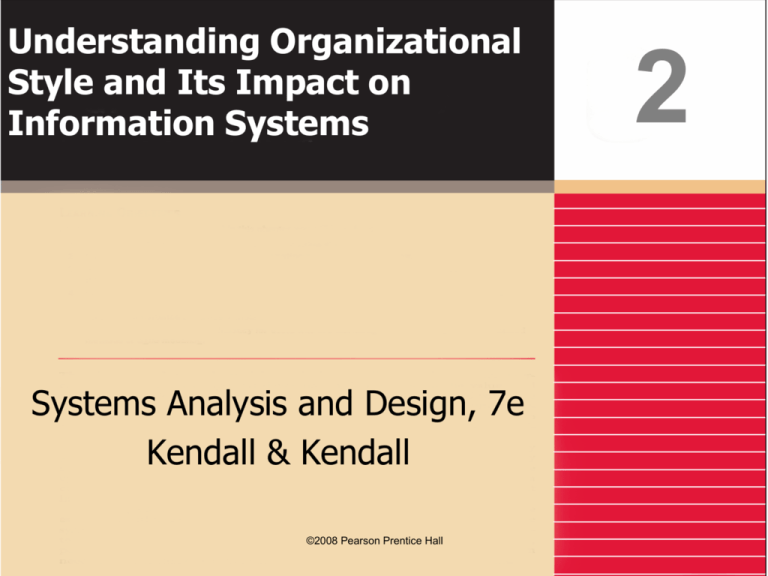
Understanding Organizational
Style and Its Impact on
Information Systems
Systems Analysis and Design, 7e
Kendall & Kendall
©2008 Pearson Prentice Hall
2
Learning Objectives
• Understand that organizations and their
members are systems and that analysts need
to take a systems perspective
• Depict systems graphically using context-level
data flow diagrams, and entity-relationship
models, use cases and use case scenarios
• Recognize that different levels of
management require different systems
• Comprehend that organizational culture
impacts the design of information systems
Kendall & Kendall
2-2
Three Main Forces Interacting to
Shape Organizations
• Levels of management
• Design of organizations
• Organizational cultures
Kendall & Kendall
2-3
Organizations Are Composed of
Interrelated Subsystems
• Influenced by levels of management
decision makers that cut horizontally
across the organizational system
• Operations
• Middle management
• Strategic management
• Influenced by organizational cultures
and subcultures
Kendall & Kendall
2-4
Major Topics
• Organizations as systems
• Depicting systems graphically
• Data flow diagram
• Entity-relationship model
• Use case modeling
• Levels of management
• Organizational culture
Kendall & Kendall
2-5
Organizations As Systems
• Conceptualized as systems designed to
accomplish predetermined goals and
objectives
• Composed of smaller, interrelated
systems serving specialized functions
• Specialized functions are reintegrated to
form an effective organizational whole
Kendall & Kendall
2-6
Interrelatedness and
Independence of Systems
• All systems and subsystems are interrelated
and interdependent
• All systems process inputs from their
environments
• All systems are contained by boundaries
separating them from their environments
• System feedback for planning and control
• An ideal system self-corrects or self-regulates
itself
Kendall & Kendall
2-7
Figure 2.1 System outputs serve as feedback
that compares performance with goals
Kendall & Kendall
2-8
Organizational Environments
• Community
• Physical location
• Demographic profile (education, income)
• Economic
• Market factors
• Competition
• Political
• State and local government
Kendall & Kendall
2-9
Openness and Closedness
• Open
• Free flow of information
• Output from one system becomes input to
another
• Closed
• Restricted access to information
• Limited by numerous rules
• Information only on a “need to know” basis
Kendall & Kendall
2-10
Virtual Organizations and Virtual
Teams
• A virtual organization has parts of the
organization in different physical
locations
• Computer networks and
communications technology are used to
bring virtual teams together to work on
projects
Kendall & Kendall
2-11
Benefits of Virtual Organizations
and Teams
• Possibility of reducing costs of physical
facilities
• More rapid response to customer needs
• Helping virtual employees to fulfill their
familial obligations to children or aging
parents
Kendall & Kendall
2-12
Taking a Systems Perspective
• Allows system analyst to understand
businesses before they begin their tasks
• It is important that members of subsystems
realize that they are interrelated with other
subsystems
• Problems occur when each manager thinks
that his/her department is the most important
• Bigger problems may occur when that
manager rises through the ranks
Kendall & Kendall
2-13
Taking a Systems Perspective
Kendall & Kendall
2-14
Taking a Systems Perspective
Kendall & Kendall
2-15
Enterprise Resource Planning
• Enterprise Resource Planning (ERP)
describes an integrated organizational
information system
• Software that helps the flow of
information between the functional
areas within the organization
Kendall & Kendall
2-16
Depicting Systems Graphically
• Context-level data flow diagrams
• Entity-relationship model
• Use Case Modeling
Kendall & Kendall
2-17
Context-Level Data Flow
Diagrams
• Focus is on the data flowing into and
out of the system and the processing of
the data
Kendall & Kendall
2-18
Figure 2.4 The basic symbols of
a data flow diagram
Kendall & Kendall
2-19
Airline Reservation System
Kendall & Kendall
2-20
Entity-Relationship Model
• Focus is on the entities and their
relationships within the organizational
system
Kendall & Kendall
2-21
Relationships
• Relationships show how the entities are
connected
• Three types of relationships
• One-to-one
• One-to-many
• Many-to-many
Kendall & Kendall
2-22
Entity-Relationship Example
Kendall & Kendall
2-23
Figure 2.8 Examples of different types of
relationships in E-R diagrams
Kendall & Kendall
2-24
Entities
• Fundamental entity
• Associative entity
• Attributive entity
Kendall & Kendall
2-25
Figure 2.9 Three different types
of entities used in E-R diagrams
Kendall & Kendall
2-26
Attributes
• Data attributes may be added to the
diagram
Patron
Kendall & Kendall
Patron Name
Patron address
Patron phone
Patron credit card
2-27
Creating Entity-Relationship
Diagrams
• List the entities in the organization
• Choose key entities to narrow the scope
of the problem
• Identify what the primary entity should
be
• Confirm the results of the above
through data gathering
Kendall & Kendall
2-28
Figure 2-12 A more complete E-R diagram
showing data attributes of the entities
Kendall & Kendall
2-29
Use Case Modeling
• Describes what a system does without
describing how the system does it; that
is, it is a logical model of the system
Kendall & Kendall
2-30
Use Case Diagram
• Actor
• Refers to a particular role of a user of the system
• Similar to external entities; they exist outside of
the system
• Use case symbols
• An oval indicating the task of the use case
• Connecting lines
• Arrows and lines used to diagram behavioral
relationships
Kendall & Kendall
2-31
Actor
• Divided into two groups
• Primary actors
• Supply data or receive information from the
system
• Provide details on what the use case should do
• Supporting actors
• Help to keep the system running or provide
help
• The people who run the help desk, the
analysts, programmers, and so on
Kendall & Kendall
2-32
A Use Case Always Provides
Three Things
• An actor that initiates an event
• The event that triggers a use case
• The use case that performs the actions
triggered by the event
Kendall & Kendall
2-33
Use Case Relations
• Behavioral relationships
• Communicates
• Used to connect an actor to a use case
• Includes
• Describes the situation in which a use
case contains behavior that is common
to more than one use case
Kendall & Kendall
2-34
Use Case Relations
• Behavioral relationships (Continued)
• Extends
• Describes the situation in which one use
case possesses the behavior that allows
the new case to handle a variation or
exception from the basic use case
• Generalizes
• Implies that one thing is more typical
than the other thing
Kendall & Kendall
2-35
Figure 2.13 Some components of use case diagrams
showing actors, use cases, and relationships for a
student enrollment example
Kendall & Kendall
2-36
Figure 2.14 Examples of use cases and
behavioral relationships for student enrollment
Kendall & Kendall
2-37
Developing Use Case Diagrams
• Review the business specifications and
identify the actors involved
• Identify the high-level events and develop the
primary use cases that describe those events
and how the actors initiate them
• Review each primary use case to determine
the possible variations of flow through the
use case
• The context-level data flow diagram could act
as a starting point for creating a use case
Kendall & Kendall
2-38
Figure 2.15 A use case diagram representing a
system used to plan a conference
Kendall & Kendall
2-39
Developing the Use Case
Scenarios
• The description of the use case
• Three main areas
• Use case identifiers and initiators
• Steps performed
• Conditions, assumptions, and questions
Kendall & Kendall
2-40
Figure 2.16 A use case scenario is divided into three
sections: identification and initiation; steps performed;
and conditions, assumptions, and questions
Kendall & Kendall
2-41
Why Use Case Diagrams Are
Helpful
• Identify all the actors in the problem
domain
• Actions that need to be completed are
also clearly shown on the use case
diagram
• The use case scenario is also
worthwhile
• Simplicity and lack of technical detail
Kendall & Kendall
2-42
Figure 2.17 The main reasons for writing use
cases are their effectiveness in communicating
with users and their capturing of user stories
Kendall & Kendall
2-43
Figure 2.18 Management in organizations exists on
three horizontal levels: operational control, managerial
planning and control, and strategic management
Kendall & Kendall
2-44
Operations Control
• Make decisions using predetermined
rules that have predictable outcomes
• Oversee the operating details of the
organization
Kendall & Kendall
2-45
Managerial Planning and
Control
• Make short-term planning and control
decisions about resources and
organizational objectives
• Decisions may be partly operational and
partly strategic
Kendall & Kendall
2-46
Strategic Management
• Look outward from the organization to
the future
• Make decisions that will guide middle
and operations managers
• Work in highly uncertain decisionmaking environment
• Define the organization as a whole
Kendall & Kendall
2-47
Managerial Levels
•
•
•
•
•
•
Different organization structure
Leadership style
Technological considerations
Organization culture
Human interaction
All carry implications for the analysis
and design of information systems
Kendall & Kendall
2-48
Organizational Culture
• Organizations have cultures and
subcultures
• Learn from verbal and nonverbal
symbolism
Kendall & Kendall
2-49
Verbal Symbolism
•
•
•
•
Myths
Metaphors
Visions
Humor
Kendall & Kendall
2-50
Nonverbal Symbolism
• Shared artifacts
• Trophies, etc.
• Rites and rituals
• Promotions
• Birthdays, etc.
• Clothing worn
• Office placement and decorations
Kendall & Kendall
2-51
Summary
• Organizational fundamentals
• Organizations as systems
• Levels of management
• Organizational culture
• Graphical representation of systems
• DFD
• ERD
• Use case diagrams and scenarios
Kendall & Kendall
2-52
Summary (Continued)
• Levels of managerial control
• Operational
• Middle management
• Strategic
• Organizational culture
Kendall & Kendall
2-53

